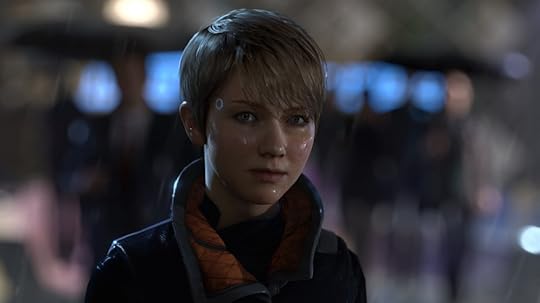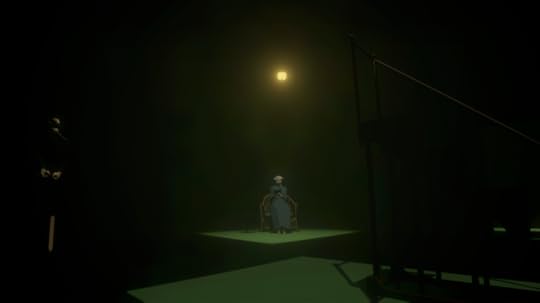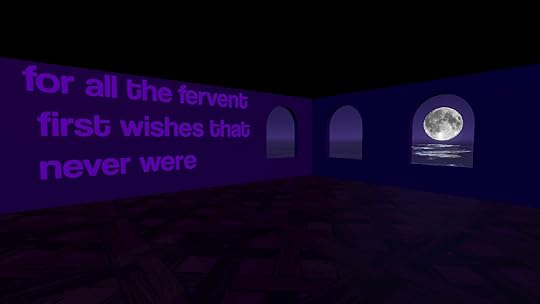Kill Screen Magazine's Blog, page 204
October 28, 2015
One of the best horror movies of the millennium is a YouTube compilation of Silent Hill 2���s cutscenes
In my restless dreams, I see that YouTube compilation...
With Detroit: Become Human, David Cage makes some uncomfortable parallels
David Cage, the game developer equivalent of an ex-boyfriend who refuses to accept you'll never love each other the same way again, announced his next title at Paris Game Week yesterday. Coming off the heels of Indigo Prophecy, a game often touted as ahead of its time, and more recently Beyond: Two Souls and Heavy Rain, games often touted as generally pretty useless, Cage released a conceptual trailer for a project he's calling Detroit.
Okay, that's not the full title. The full title to David Cage's next game is cringingly—no, sickeningly—Detroit: Become Human. Originating from the 2012 tech demo called Kara, Detroit will continue the story of a female android who accidentally develops sentience somehow. The trailer hints at a sci-fi story involving robot rebellions and, as Cage says, questions about "what it means to be human." There's no set release date for the game, but it claims to be a PS4 exclusive.

The most interesting part of this announcement, though, isn't really the game itself. Because the media coverage for Detroit: Become Human has been—well—decidedly "meh" about the whole thing. The Verge describes David Cage's past titles as striving "to be emotionally poignant yet often [struggling] to hit their lofty goals," conceding that, regardless, "that won't stop director David Cage from trying." The Verge also wagers you can bet "there will definitely be a few moments that try to make you cry" in the newest game.
"Quantic Dream and Cage are known for attempting to tell ambitious stories," says Venture Beat, "but as we saw with Heavy Rain and Beyond: Two Souls in the PlayStation 3 era, their end product doesn’t always meet their ambitions." Which, for Venture Beat, is a positively scathing remark.
"that won't stop director David Cage from trying"
In fact, from what I can tell, the most enthusiastic response to the announcement of Detroit: Become Human comes from Cage himself:
"Many people were deeply moved by [the original Kara] and felt empathy for this character who just wanted to live," he explains on the PlayStation Blog. "But everyone had the same question: what happens to Kara when she leaves the factory? I kept asking myself the same question since we released this short. I knew I had to find out!"
But, oddly enough, Cage isn't totally wrong. There were some genuinely interesting ideas in the original tech demo, Kara, (though those ideas were also not immune to the usual so-on-the-nose-it-hurts David Cage-ness). In the original, a feminist undertone characterizes Kara's "birth." She becomes sentient only to learn that her body is to be bought and sold to the highest bidder. She is like Eve, discovering herself for the first time in a watery reflection in the Garden, only to be interrupted by God and told she is subservient—the bone of another, a reflection only meaningful insofar as it reflects man's greatness.
In the trailer to Detroit: Become Human, a half-assed allusion to slavery is attempted instead—I think? (I hope not, but I think so.) With the title's uncomfortable juxtaposition of Detroit—a city known for its history of race riots and current race-related drug, education, and housing problems—and the tagline "Become Human," coupled with the heavily implied metaphor to slavery, Quantic Dreams appear to be drawing unavoidable parallels. Or, actually, I don't know what would be worse: if Cage genuinely does not see the racial lines he is drawing with Detroit: Become Human, or if he genuinely thinks drawing those comparisons is a good idea. Regardless, the number of white robots being subjected to robot slavery/racism in Detroit makes me uncomfortable.
In the end, however, all is speculation this early in the game. For now, I'll save my outrage for when the inevitable Kara shower scene becomes a controversy.
The unified theory of all zombie fiction
The core of all zombie fiction isn’t brains. It’s heart
No Man's Sky's newest trailer reveals a release window at last
The new No Man’s Sky trailer kicks off with a Blade Runner-esque “I’ve seen things…” monologue and concludes with a date. It’s not an exact release date, but it is something to look forward to: June 2016 on PC and PlayStation 4.
On display in the video are the same bright galaxies and vibrant wildlife that have become so iconic of No Man’s Sky. We also get a look at some combat and, perhaps more interestingly, the discovery of a planet.
An overlay during the ship’s descent onto the new world indicates the username of the player who made the discovery, a reminder of the fact that No Man’s Sky’s vast universe is the same for all players. Finding and sharing new knowledge with others will play a role in your journey.
colorful interplanetary travels
The last big info dump for No Man’s Sky was back in July. With the release date still eight months out, we'll probably see plenty more of its colorful interplanetary travels in the near future.
No Man's Sky will be out on PC and PlayStation 4 in June 2016.
We Need to Stop Letting Everyone Save the World
Did you beat Life is Strange? Let’s have a chat, then.
October 27, 2015
Oxenfree's supernatural teen thriller is set for transmission this January
After two months of silence, Night School Studio has some exciting things to share about their upcoming “supernatural teen thriller,” Oxenfree: a release timeframe of January 2016 with a console debut exclusively on Xbox One, and a brand new teaser.
This new video gives a much clearer look at Oxenfree’s story and character drama than past trailers. Take a look below.
It’s been known that the game’s otherworldly happenings occur after your character Alex tunes into a strange transmission on the island she and her friends are partying on. Edwards Island, as it’s called, is home to an abandoned military base and the place where local seniors like Alex spend the night as a sort of rite of passage near the end of high school.
ghostly technological horrors
Now we also know that Alex’s parents are divorced, her recently remarried mother is off on her honeymoon, and she’s left to reluctantly drag her new stepbrother Jonas to the island party as well. This also takes place near the anniversary of a character named Michael’s death, which Alex references in a call to her father. Perhaps this was Alex’s real brother?
With Oxenfree being compared to Stand By Me as much as Poltergeist, it’ll be interesting to see how the family drama and the dynamic between these young, adventurous kids plays out against the backdrop of the island’s ghostly technological horrors.
Learn more about Oxenfree on its website.
Might and Delight's latest trailer for Child Cooper is a feast for your eyes
"In a lot of ways, you could call us an art collective," says Vic Bassey, COO of Might and Delight, the creators of the naturalistic game series Shelter. "We’re a small team of extremely creative thinkers and doers with an appreciation of the arts. Be it literature, music or more contemporary forms of expression. We simply use games as a medium to bring all those many elements together."

The studio's latest endeavor is Child of Cooper, a mysterious yet gorgeous low-poly game described as a visual narrative. Though the team wants to keep people guessing about the exact parameters of Child of Cooper, the art style is telling in itself. Since the game is "steeped in a history of fragmented memories" Might and Delight aimed to create a style that reflected fragmentation, going for "dark, moody tones that accentuate the surreal environments."
"the sense of the unknown contributing to the unsettling mood of the game"
Bassey describes it as a journey through the deepest recesses of memory, where players will have to revisit the titular protagonist's most traumatic experience. "As kids, when we think back to old memories they are normally clouded with certain aspects exaggerated or lost to time depending on our perspective," Bassey says. "That larger than life feeling is what we wanted to recreate with the sense of the unknown contributing to the unsettling mood of the game." Maintaining the theme of fragmentation, the story behind Child of Cooper "is then defined by the player's pacing as they move across multiple points in the world." Because the focus will be on perspective, the game will benefit from multiple playthroughs, allowing the player to se the scene more fully and respond to their minor exploratory choices.
Foregoing any usual tutorial or HUD, Might and Delight wants this game to intimately respond to player intuition. The game even allows for the player to decide how they want to play the game, based on their initial assumptions of how they believe the button configurations should be. "It does sound extremely self-indulgent," Bassey says. "And in a lot of ways it is."
"It does sound extremely self-indulgent"
Judging from the trailer, this kind of decadent self-indulgence is one I'll be able to get behind. Each scene, despite its moody and dark undertone, is a feast for your eyes. The people appear to hang in suspension, while smoke still billows and blood runs down a wall. There's a quiet yet revelatory feeling to every atmosphere, which will only be heightened by Might and Delight's recent announcement that Child of Cooper will be the team's first foray into virtual reality.
You can keep up to date with Child of Cooper through the studio's website.




A war game uses Morse code to slow you down. That's a good thing
. _ _ ._ ._.
Explore a lonely house in this videogame about accepting absence
If you've ever moved house you should be familiar with the peculiar act of emptying familiar spaces. In doing this myself, I've come to realize that memories not only lie within the objects we own but also the walls and floors we have them occupy. The difference is that we have to leave those memories behind with the architecture (it's why I always take a long last glance of each empty room before shutting the door). There's a sadness to this.
I see this captured in Albert Lai's (creator of 2:22AM) exploration game ten moons. He calls it a "mood piece set in a house on the sea" and it's worth noting that it was made for CloneJamKittyHorrorshow—a three-day game jam that challenged participants to create games inspired by Kitty Horrorshow. What Lai seems to have taken from Kitty is her penchant for "sad architecture" (as I've previously called it). This is communicated visually through the lonely house that comes cast in a gloomy dark purple. But Lai doubles down on it with the game's poetic text.
these objects never existed in the first place.
This text is written across the walls (and once on the ceiling) of the vacant house. However, it only appears inside a room once you've walked into an object spinning in the middle of it. The first is a birthday cake, and the text that follows is dedicated to "all the birthdays that never were" and "the fervent first wishes that never were." Each of the verses correspond to the object that triggered them in such a way, and it's always to remark on absences.
I've deliberately refrained from saying that you 'collect' these objects. This is the action that would typically be implied in a videogame when you walk into an object for it to disappear. But the point in ten moons seems to be to subvert this expectation and to infer that these objects never existed in the first place. We are lured towards these shiny trinkets, but there's no celebratory sound effect upon arrival, no new icon in an inventory system; we are denied any and all access to them.

Through this, what we do acquire is a list of experiences that an unseen character hasn't had, but clearly wishes they did. It achieves in us an unusual desire to scan the walls for insight. However, there isn't enough inside the game itself to explain why this person has missed out on so much—it's a game that begs for interpretation. That said, I find it interesting that Lai jokingly (or not?) rephrased a line from Tolstoy's novel Anna Karenina to make it about the invisible walls he was putting inside ten moons at the time. "Happy families are all alike; every unhappy family is unhappy in its own way" becomes "all visible walls are alike; each invisible wall is invisible in its own way."
It may just be a joke, but there are certainly thematic connections to be made here. The idea that the building in ten moons is a broken home isn't outlandish. Not only do we have those denied memory spaces and lost dreams as evidence, but the house itself is also swallowed by the sea as you explore it. This could be a metaphor for how building a family (or relationships) on weak foundations will only lead it to sink. But it's not all doom and gloom. It is perhaps a little banal (although the delivery isn't) but the game's ending tells us that the process of accepting loss and absence may be necessary in finding a brighter future, which isn't dissimilar from the ending of Kitty Horrorshow's Rain, House, Eternity.
As an aside, I came across two endings in ten moons: one intended, the other accidental. The first and authored one (spoiler alert!) sees the house falling away completely to leave you to walk through an open door—the idea presumably being that you're moving on to somewhere better. But when I played through ten moons the first time I stepped onto a stairwell the moment that the house sunk and it pulled me with it. This left me to fall endlessly into a voidspace surrounded by an image of the rising sun. It could be read to have an identical meaning to the proper end but by leaving me in that warm image it seemed to be even more profound. It's worth seeking out this alternative ending for its lingering message.
You can download ten moons on itch.io.
Transformers: Devastation is a Platinum-strength exercise in nostalgia
Look back in anger.
Kill Screen Magazine's Blog
- Kill Screen Magazine's profile
- 4 followers



